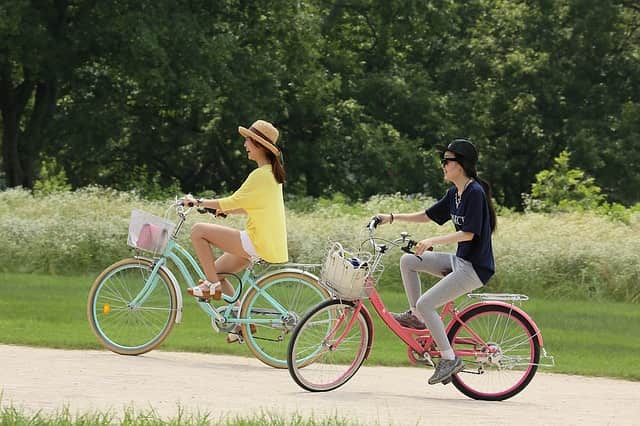It can be confusing to figure out the differences between men’s and women’s road bikes. After all, these two bikes have some minor yet important differences that you should consider before buying your next ride.
From different frame geometries and component sizing to saddle design, there is much more involved in choosing a bike than just getting something in the right size frame.
In this article, we will explain why understanding the subtle nuances of men’s and women’s road bikes is so important and go in-depth on the history, key difference and reasons why bike manufacturers differentiate between men’s and women’s bikes even today.
History of Men’s vs Women’s Bikes
Bicycles were once considered an exclusively male invention in the early 19th century. It was a machine that exuded adventure, a symbol of masculinity reserved for bold and intrepid men.
However, as the late 19th century rolled around, women also wanted to take part in this new trend, and so, the idea of designing a specific bike that is more fitting for women was born.
Women’s bikes were crafted to be smaller, lighter, and more feminine as compared to men’s bikes that were sportier and more high-performance.
One defining feature of women’s bikes was the step-through frame and inclined top tubes that allowed easier access without displaying too much skin.
Today, this feature has become a relic of the past as cycling attire has evolved from skirts to pants, and the distinction between men’s and women’s bikes has become much more blurred.
Why Are Men’s and Women’s Bikes Different?
Gone are the days when men’s and women’s bikes were vastly different from one another. While men’s bikes were thought of as sportier, women’s bikes were smaller, lighter and had a more aesthetically pleasing design.
But, times have changed and for the better. Nowadays, the differences between men’s and women’s bike are much more minor and primarily related to size and fit.
Body Measurements | US Men | US Women |
Height in inches | 69.0 | 63.5 |
Weight in pounds | 199.8 | 170.8 |
Waist circumference in inches | 40.5 | 38.7 |
It’s much like clothing, which is designed to accommodate the structural differences between male and female bodies. Men are on average taller, larger and heavier than women.
Women, on the other hand, have proportionally longer legs and wider hips. These distinct physical differences, along with marketing considerations, are the driving force behind the design of women’s bikes.
For example, women traditionally prefer bright colors while men choose different shades of dark.
Major Differences Between Men & Women Road Bikes
When it comes to bikes, gender-specific models may seem like a marketing gimmick, but there are subtle differences that cater to the physical needs of men and women.
Although these differences may not be apparent at first glance, these small changes between men and women bikes can make a significant difference in comfort and performance.
Frame Size
When it comes to road bikes, one of the biggest differences between men’s and women’s options lies in the frame size. However, it’s important to note that this doesn’t simply mean a smaller version of the men’s bike.
Certain components are altered to better serve the average female build.
Women tend to be shorter than men, which means that women’s bikes often feature a shorter stack height and a shorter reach length to accommodate a shorter torso.
But perhaps the most noticeable difference is the lower top tube on women’s frames, which shortens the distance between the bottom bracket and the head tube.
These alterations aim to make for a more comfortable and efficient ride for women.
Saddle
When it comes to road bikes, another most noticeable differences between men’s and women’s bikes is the saddle. Women’s bikes tend to have shorter and wider saddles, while men’s saddles are narrower.
This is because women typically have wider pelvic bones and need more surface area directed towards the rear to provide sit bone reinforcement.
Performance riders, regardless of gender, usually prefer a narrower saddle to give them more room for pedalling. However, casual riders may prefer the added comfort of a wider saddle.
So, whether you’re a man or a woman, it’s important to choose a saddle that fits your body and provides the comfort and support you need while cycling.
In higher-quality bikes, it’s normal for both genders to have a space in the center of the saddle to improve ventilation, relieve pressure, and provide an overall more comfortable ride.
Frame Structure
When it comes to bikes, there are structural differences between men and women’s models.
While not all bikes are different, women’s bikes often feature a low-step frame, while men’s bikes have a crossbar or step-over frame.
This difference dates back to a time when women primarily wore skirts and dresses, and the lack of a crossbar made it easier for them to mount and dismount their bikes.
While it’s now common to see men riding step-through bikes.
However, it’s worth noting that step-through bikes have remained more popular among women, as they continue to be featured in popular culture as a women’s bike.
Ultimately, whether you ride a step-through or crossbar bike comes down to personal preference and comfort.

Handlebars
This is a feature that many people will have noticed can vary to a great degree and as such can have a massive impact on your cycling.
Men generally have wider shoulders and longer arms than women and as such have a wider grip when cycling.
This is why bikes designed for men typically come with wider, lower set handlebars and their grip handles are spaced further.
Women’s are ordinarily designed to be shorter, narrower, and are set higher to compensate for shorter arms.
As each person is built differently, these assumptions may not always fit someone accurately and as such it’s important to remember that adjustments are always welcomed to help you ride comfortably.
Stack & Reach
When it comes to biking, one crucial aspect to consider is the stack and reach measurements of the bike.
In essence, stack determines the height of the handlebars from the bottom bracket, while reach defines the distance from the same bracket to the handlebars.
Although these measurements apply to both men’s and women’s bikes, there is a difference in the numbers due to the contrasting anatomy of the sexes.
Women’s bikes typically have a shorter stack and reach, given that females’ height and torso dimensions are generally smaller than males’.
Suspension
The discussion of whether men and women need different suspension on their bikes often arises, but it’s not a huge concern when shopping for a bike.
Both men’s and women’s bikes typically have a similar suspension set-up that can be adjusted to fit your weight.
Adjusting the suspension is a relatively easy task you can do at home, and if you require further assistance or have any issues, don’t hesitate to visit your local bike shop.
While men’s and women’s bikes’ suspension may differ, it’s designed to ensure that both sexes get the optimum ride comfort they need.
Men’s bikes are built to handle more compression because of their weight, while women’s bikes have a suspension set-up that accommodates their lighter weight.
Seatpost
Bikes designed for women typically have a shorter seatpost than those for men. This is due to the fact that women are generally shorter in stature than their male counterparts.
However, adjusting the height of the seatpost is an effortless and straightforward process. It allows you to tailor the bike to your specific needs and riding preference.
Whether you’re tackling trails or cruising around town, the right saddle height can make all the difference in your overall comfort and enjoyment while riding.
So, if you’re in the market for a new bike, be sure to keep this in mind and choose a bike with a seatpost length that works best for you.
Brakes
One of the most important features of a bike, it’s important to mention that the breaks don’t differ much between the genders they were created for.
In fact, the only difference between the designs is the adjustment to the size of the brake levers.
Brake levers are another feature that is adjusted to suit the gender of its owner, and as the tool needed for engaging the brakes on the bike, is important to get right.
As women’s hands are normally smaller on average, the size of the brake levers is adjusted to be easier to maneuver. Men’s hands are generally larger and as such their bikes have larger brake levers.
While this adjustment can be important for some people that may struggle, it is usually a small difference that isn’t always necessary for many cyclists.
Crankset
When it comes to biking, the crankset is an essential component that connects your pedals to the rest of your bike. Interestingly, there’s a difference in crank length between men and women’s bikes.
Men’s bikes typically have a 170mm crank length, while women’s bikes have a slightly shorter 165mm length. This variation is meant to accommodate the longer legs of men compared to women.
While it may seem like a minor adjustment, it can significantly improve a cyclist’s comfort and performance.

Conclusion
It is important to remember that the differences between men’s and women’s bicycles are much more in-depth than just the frame size.
Identifying these key factors and accordingly selecting a bike model will help riders have many satisfactory riding experiences.
Ultimately, understanding the major differences between men’s and women’s bikes will be helpful in making an informed decision about what bike to purchase for your needs.
Also Read
Is Orbea A Good Bike Brand? Know This Before Buying!







![26 Inch Bike for What Size Person? [ Bike Size With Charts ] 26 Inch Bike for What Size Person? [ Bike Size With Charts ]](https://goingfitunfit.com/wp-content/uploads/2021/12/bike-size-guide-150x150.jpg)

True that. I guess a custom bike would be good if you are not an average size for your sex. I’m average but I’m a bit overweight. When I used to get a women’s road bike in the past, I felt too much pain to ride it.
Thank you for sharing